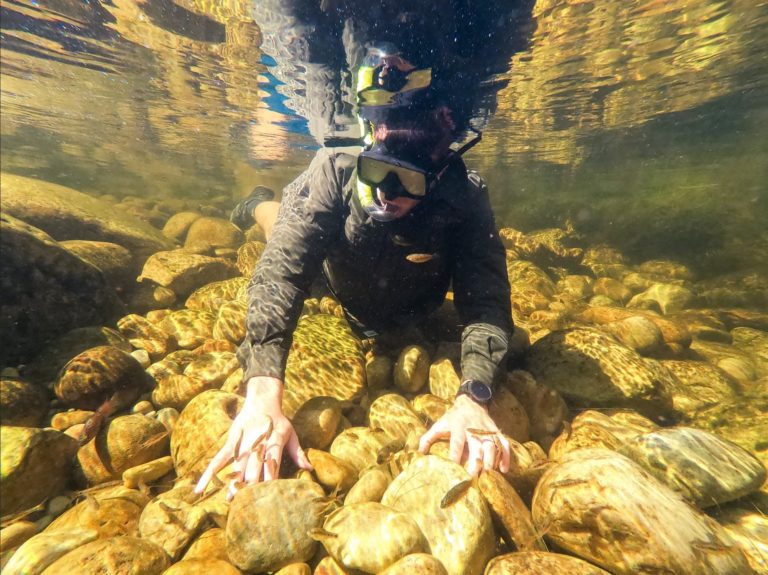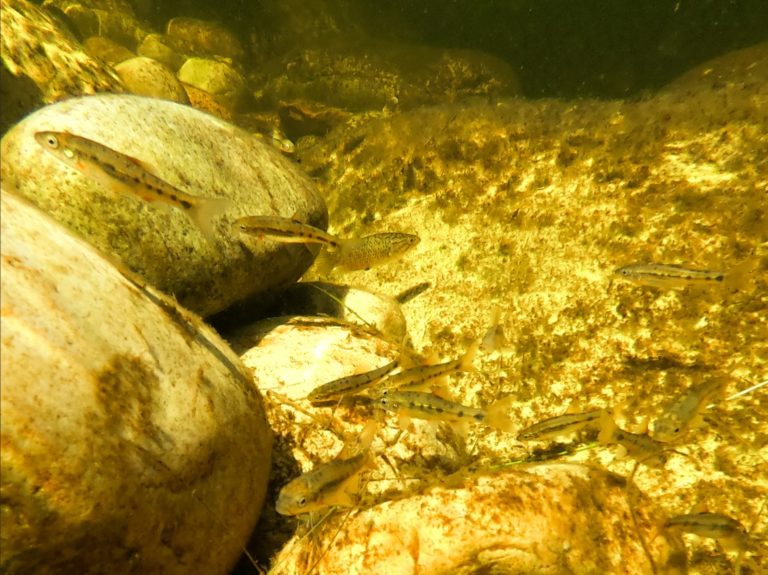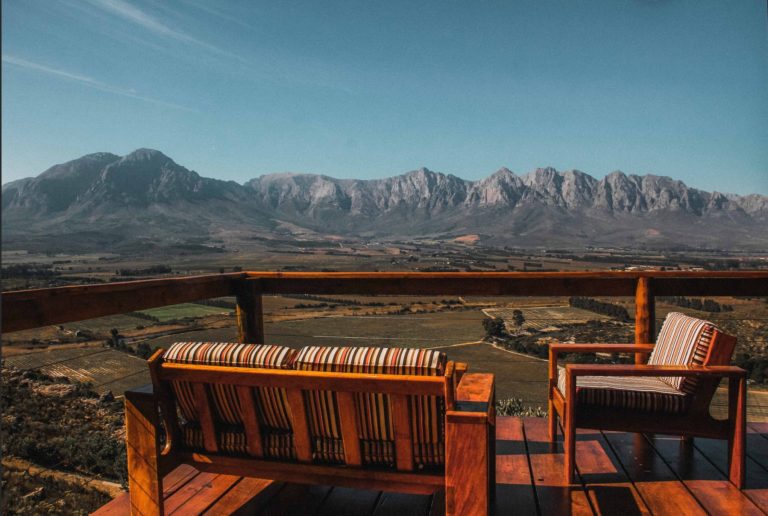[ad_1]
Okay, possibly not Rambo. And never Chuck Norris, both. However a hike by Bainskloof on a quest for an endangered fish made Jay Caboz really feel as intrepid as any big-screen motion hero
For a typical Capetonian, a snorkel journey begins with wetsuit, masks and fins – after which that awkward waddle throughout the seashore. This units off a collection of disturbing psychological visualisations of a gasping plunge into the icy Atlantic with the reward of a bone-chilling, but chic swim by moody kelp forests on an expedition to spy on fish and nudibranchs, possibly swim with seals and have penguins pop into the water with you. When you’re fortunate, that’s.
Which is why, after I was provided the chance to snorkel with among the world’s rarest fish, a species solely discovered within the Western Cape, I by no means anticipated that discovering them would imply travelling 100km inland.
Such was the case when I discovered myself subsequent to journey and journey information Nico Meyer, on a blisteringly scorching summer season morning at Tweede Tol campsite on the Bainskloof mountain move. We have been, I’d been informed, heading deep into the guts of Limietberg Nature Reserve.
I hopped out of the automotive totally geared up. Mountain climbing boots, trekking poles, and a heavy backpack laden with the GoPro, digicam, tripod, sunblock and path combine.

Nico’s skilled side-eye took me and my paraphernalia in. ‘We’re going straight up the river, like Rambo,’ he mentioned. ‘I don’t suppose your digicam gear’s going to outlive; it’s extremely unlikely you’ll make it to the realm the place they reside with out getting moist.’
With a decade spent working as a ranger at five-star sport reserves, Nico match the character information mould completely. Proper all the way down to the khaki shirt and pants and dry sense of humour. When you’ve seen Stallone’s Rambo flicks, you may think about the anguish that took me by the scruff of my neck. I knew we had a 6km hike to get to the fish, however had I fully underestimated the terrain we have been about to traverse?
‘Don’t fear,’ Nico mentioned, ‘that’s why I introduced the drybag.’
And off we set on what I imagined was to be a scenic hike, following a route that winds upstream. Often, I imagined, we’d be crossing one among South Africa’s most pristine watercourses, the Witte River.
Our purpose was to search out the elusive Burchell’s redfin (Pseudobarbus burchelli), a tiny rosy fish recognized regionally because the Breede redfin.
These redfins have been once so widespread you may discover them in any stream all through the Cape Fold mountains. Sadly, their numbers have dwindled to a mere fraction of what they as soon as have been. Their inhabitants is remoted and restricted to a handful of mountain streams the place their habitat stays intact and there’s an absence of invasive fish. So uncommon actually are these ruddy redfins, that they’re listed on the IUCN Crimson Listing as critically endangered, one badly timed fishing journey from extinction.

It didn’t take lengthy for Nico’s “Rambo” foreshadowing to grow to be actuality as, simply 75m from the automotive – underneath a bridge, previous a picnic website – we stood on the river’s rocky shoreline, Nico grinning knowingly.
‘That’s the strolling performed,’ he mentioned. ‘From right here on, we swim.’
He steered that I hold my footwear on to grapple with sharp and slippery rocks, and with that, we slipped into Rambo mode, drybag in tow, boots slip-sliding over rocks, tripod on my head.
Whereas all this was taking place, and I used to be making an attempt to not fall, Nico defined how alien fish species had invaded and brought over the atmosphere. How, because of this, there was little or no life. No bugs, no small fish.
Nearly a century in the past, he mentioned, species comparable to bass and trout have been launched into Western Cape river streams. With no pure predators they rapidly tailored to their new atmosphere, inflicting the decimation of populations of smaller indigenous freshwater fish such because the redfin. In sure instances, as within the Eerste River, this precipitated the entire native extinction of redfins.
After about 25 minutes of Ramboing, we reached “The Wall”, a bit of bedrock too excessive for invasive fish species to leap over. Past this, Nico mentioned, we’d discover Breede redfin.
We arrange a basecamp on a big flat part of rock overlooking a deep pool of water that leaned towards a granite cliff face. It was brutally uncovered to the solar. However, instantly, there was a noticeable distinction within the water high quality. There was a placing distinction, too, within the life round us. Bugs floated on the floor of the swimming pools and watergrass swayed within the ripples.
As we donned our masks, Nico defined that redfins are fairly shy. The trick to discovering, he mentioned, was to snorkel slowly and make efforts to not disturb the algae.
On the pool’s edge, we plunged in. In comparison with the Atlantic, the water was pleasantly heat. Snorkel-breathing with my head submerged gave me that sense of getting entered a special world. We inched our manner across the pool, wanting in cracks and crevices to see what we may discover.
Not as elusive as I’d imagined, it wasn’t too lengthy earlier than we noticed them – a bunch of about 15 redfin, shimmering in a shoal of vitality. Every was concerning the size of a finger, their scales reflecting beams of daylight filtering by the floor as they flashed their distinctive brilliant pink fins.
We remained semi-submerged, faces within the water, misplaced on this otherworld, making an attempt to not transfer, palms prolonged, holding on to the rocky mattress to maintain ourselves underneath water.

It was a magical expertise as dozens of redfins and Cape kurper (Sandelia capensis) got here nearer. They swam by, between and round our palms and in entrance of our masks, virtually urging us to remain just a bit longer.
What struck me in these moments was a robust sense of impermanence, understanding that these uncommon creatures would possibly at any second now not exist in any respect. Right here I used to be in an enchanted alien world, communing with one thing alive and very important and on the very brink of extinction. For a short whereas, every thing else stopped mattering and that underwater bubble grew to become my complete universe.
‘It’s the silence,’ mentioned Nico, once we lastly emerged from the water. ‘That’s what will get me. Once you dip your head under water, it’s such as you’re in a special world. It’s so quiet and peaceable. And the longer you keep that manner, the nearer the redfins come to you.’
It was satisfying to have spent cherished time with these underhyped, unheralded endangered creatures, nevertheless it was nice to really feel the new solar on my shivering physique. The pool won’t be as icy because the Atlantic, however I doubt even Stallone would final too lengthy in that pure mountain run-off.
Quickly, what had been a mild breeze once we arrived was choosing up, the wind now chopping the water’s floor, disturbing the pool’s serenity. It was time to pack up.
As we navigated again by the winding river, our footwear soaked, our necks sunburnt, I puzzled if these fish would nonetheless be right here by the point my very own kids have been sufficiently old to observe Rambo reruns with me.

The details
In 2019, the South African Nationwide Biodiversity Institute discovered {that a} third of South Africa’s freshwater fish species are threatened with extinction.
At current, 20 Western Cape endemic species are thought-about “susceptible”, “endangered” or “critically endangered” by the Worldwide Union for Conservation of Nature (IUCN). The Breede redfin is taken into account to be critically endangered, one step away from extinction.
Half of South Africa’s freshwater fish species are endemic (discovered nowhere else on Earth).
In keeping with the World Wildlife Fund’s World’s Forgotten Fishes report launched final yr, freshwater biodiversity is declining at twice the speed of that within the oceans or forests. A 3rd of freshwater fish species globally are threatened with extinction. Populations of migratory freshwater fish have plunged by 76% since 1970, and megafish by a staggering 94%.
*You may contribute in the direction of fish and redfin conservation initiatives by donating to the Freshwater Analysis Centre. frcsa.org.za
DO IT
To observe in Rambo’s footsteps, you’ll want a day move from Cape Nature, and go ready with eco-friendly sunscreen, hat, masks and snorkel, water waders (or boots you don’t thoughts getting moist), and are available ready to get moist on the best way there, too.
Alternatively, e book a visit with Nico Meyer’s WILDcape, a Paarl-based tour firm aiming to attach travellers with their atmosphere and hopefully instil a deeper appreciation of the pure world. Nico conducts excursions all around the Western Cape – from disa looking on Desk Mountain to multiday Whale Path hikes. 083 263 8206 wildcapesa.co.za
Not eager to observe in Rambo’s footsteps?
Relax at one of many Tweede Tol picnic websites whereas your pals Rambo it up the river. Permits are R50 per grownup, R30 per youngster (free for Wild Card holders). Solely 120 guests are permitted per day. Gates are open from 8am to 6pm. capenature.co.za
Sleep over

Stonewood Mountain CabinOn the Bree River, this wood cabin affords a laid again rusticity retreat for as much as six individuals. From R2 100 pn on weekdays. stonewoodmountaincabin.com
Arum Lily Cottage and Log Cabin
A 30-minute drive from Bainskloof and situated on the sting of a dam, these two family-sized home-from-home choices are nice if it’s good to relaxation up after your Rambo mission. From R1 600 pp pn. arumlilycottage.co.za
AfriCamps at Doolhof
In Wellington’s picturesque backcountry, you may glamp at Doolhof Wine Property, the place mountain biking, wine tasting and spa therapies are on provide. From R1 940 for 2, though tents accommodate 5 individuals. africamps.com
Redfin titbits
The Breede redfin grows to about 120mm, concerning the size of your index finger. As their identify suggests, they are often recognized by their distinctive pink fins.
The fry and juveniles kind massive shoals, whereas adults happen in small teams.They’re backside to midwater feeders. They prey on something from tiny invertebrates to bugs, larvae, in addition to zooplankton and algae.
The perfect season to swim with the Breede redfin is summer season, when the climate is heat and – in preparation for breeding season – their colouring is at its most placing, the males placing on their finest present to draw females.
This text initially appeared within the print challenge of Getaway in June 2022
Phrases and pictures by Jay Caboz
Observe us on social media for extra journey information, inspiration, and guides. You can even tag us to be featured.
TikTok | Instagram | Fb | Twitter
ALSO READ: 10 enchanting mountain cabins within the Western Cape for a peaceable retreat
[ad_2]
Source link


Leave a Reply